584
51 There was a kind of conjunction between the planets Mars and Jupiter
bound to happen in August 14 AD 2024:
|
SEPT 26 |
27 (270) |
28 |
29
(272 → 4 * 68) |
30 (*193) |
 |
 |
 |
 |
 |
|
Ga7-20 |
Ga7-21 |
Ga7-22 |
Ga7-23 (192
→ SPICA) |
Ga7-24 |
|
ATRIA = α Tr. Austr.
(253.9) |
Tail-6 (Tiger)
WEI
(Tail) = ε Scorpii,
η Arae (254.3),
DENEBAKRAB = μ Scorpii
(254.7) |
ι Ophiuchi (255.3),
GRAFIAS = ζ Scorpii (255.4)
*214.0 = *255.4 -
*41.4 |
κ Ophiuchi (256.2), ζ Arae
(256.5), ε Arae (256.8),
CUJAM (Club) = ε
Herculi
(256.9) |
No star listed (257) |
|
Nov 29 |
30 (*254) |
Dec 1 |
2 (336) |
3 |
|
°Nov 25 |
26 (*250) |
27 |
28 (332) |
29 |
|
'Nov
2 |
3 (*227) |
4 |
5 |
6 (310) |
|
"Oct 19 |
20 (*213) |
21 |
22 (295) |
23 |
|
20 Sept |
21 Sept (264) |
22 Sept |
23 Sept |
24 Sept (*187) |
|
NAKSHATRA VIEW: |
|
MARCH 28 (*372) |
29 |
30 (454 = 271 + 183) |
31 |
APRIL 1
(91) |
|
TABIT = π³ Orionis
(71.7), π² Orionis (71.9) |
π4 Orionis (72.1),
ο¹ Orionis
(72.4),
π5 Orionis (72.8) |
π¹ Orionis (73.0),
ο² Orionis (73.4),
HASSALEH = ι Aurigae
(73.6), π6 Orionis (73.9)
*32.0 = *73.4 -
*41.4 |
ALMAAZ (The Male
Goat) = ε Aurigae
(74.7),
HAEDUS I =
ζ
Aurigae
(74.8) |
HAEDUS II = η
Aurigae
(75.9)
Aug 14 AD 2024 (226, *146)
MARS & JUPITER |
|
May 31 |
June 1
(152) |
2 (*73) |
3 |
4
(*440 = *376 + *64) |
|
°May 27 |
28 (148) |
29 |
30 |
31 (*436) |
|
'May
4 (124) |
5 (*45) |
6 |
7 |
8 (*413) |
|
"April
20 |
21 (111 = 152 - 41) |
22
(*32) |
23 |
24 (*399) |
|
22 March |
23 March |
(448
→ 64 weeks) |
25 March |
26 March (*370) |
 |
 |
 |
 |
 |
|
Ga1-7 |
Ga1-8 |
Ga1-9 |
Ga1-10 |
Ga1-11 |
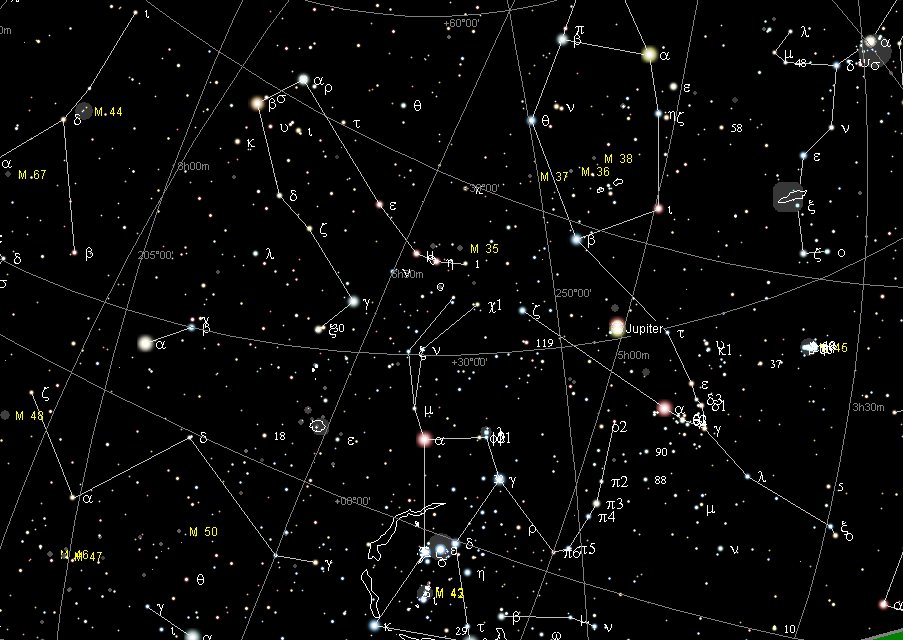
They were close together in time-space, reaching the line
(string) for right ascension *146 in August 14 AD 2024 (a leap
year - when the Sun calendar would be adjusted in order to come in tune
with the stars in the night).
But *146 (→ 2 * 73 → September 30)
was *73 right ascension days later than *73 (June 2, 153
→ 273 - 2 * 60), when the Sun had
been rising at the horizon in the east together with Hassaleh
and the pair
π¹ Orionis (*73.0), ο²
Orionis (*73.4) - in the left hand of Orion hidden behind the
hairy Lion:
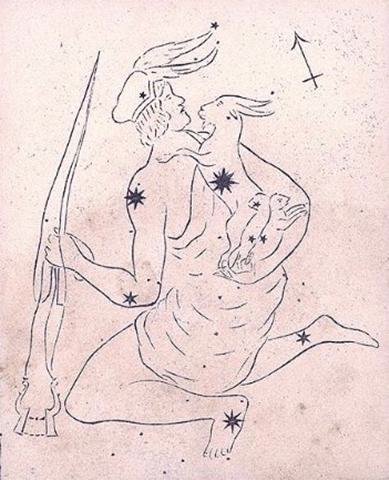
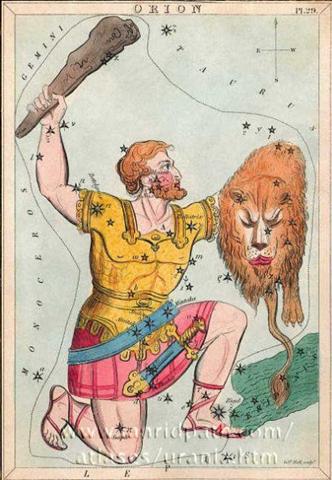
In relation to the synodic cycle of
Venus (584 days) my observations above will fit in nicely,
because 584 / 73 = 8.
And then we can also look at the
Gate of the Goat (Haedus I and II) as described on side b of the
G tablet:

|
MARCH 31 (90,
455, '10) |
APRIL 1 |
|
2 (80 + 12) |
3 (93) |
 |
 |
 |
 |
|
Ga1-10 |
Ga1-11 |
Ga1-12 |
Ga1-13 ↔ 378 -
365 |
 |
 |
 |
 |
|
Gb5-22 (146
→ 2 * 73) |
Gb5-23 |
Gb5-24 (92 + 365
- 80 = 377) |
Gb5-25 (378 → Saturn) |
|
ALMAAZ (The Male Goat) = ε Aurigae
(74.7),
HAEDUS I =
ζ
Aurigae
(74.8) |
HAEDUS II = η Aurigae
(75.9)
Aug
14 AD 2024 (226, *146)
MARS & JUPITER |
5h (*76.1)
ε Leporis (76.0),
ι Tauri
(76.2),
CURSA (Footstool) = β Eridani (76.4),
λ Eridani (76.7),
Ψ (65) Eridani (76.8)
*35.0 = *76.4 - *41.4
Dec 6
AD 2022 (340, *260)
MARS |
μ Aurigae, μ Leporis (77.6) |
 |
|
June 3 |
4 (*75) |
|
5 (40 + 4 * 29) |
6 (157 ↔ 314 / 2) |
|
°May 30 (150) |
31 |
°June 1 (*72) |
2 (153) |
|
'May 7 |
8 (128) |
9 (*414 ↔ *49 +
*365) |
10 (*50 ↔ *77 -
*27) |
|
"April 23 |
24 (*399) |
25 (115 = 156 - 41) |
26 (*36 = *77 -
*41) |
|
... Later on in
this series of rituals, the Chorti go through
a ceremony they call raising the sky. This ritual
takes place at midnight on the twenty-fifth of April
and continues each night until the rains arrive. In
this ceremony two diviners and their wives sit on
benches so that they occupy the corner positions of
the cosmic square. They take their seats in the same
order as the stones were placed, with the men on the
eastern side and the women on the west. The ritual
actions of sitting down and lifting upward are done
with great precision and care, because they are
directly related to the actions done by the gods at
Creation. The people represent the gods of the four
corners and the clouds that cover the earth. As they
rise from their seats, they metaphorically lift the
sky. If their lifting motion is
uneven, the rains will be
irregular and harmful ...
Ariki
1. King, ruler, member of the nobility,
Ariki henua, king; members of the royal
family, descending from Hotu Matu'a;
noble, nobility, chief. 2. Divine being,
superior being. Ariki Paka, certain
collateral descendents of Hotu Matu'a,
who exercised religious functions. Vanaga.
Chief, king, lord, headman in general.
Hakaariki, to make one a king. P Pau., Mgv.:
ariki, chief. Mq.: aiki, id. Ta.:
arii, id. The Marquesan use both aiki
and hakaiki in the same sense; the latter
forms with Mangarevan akariki a
subordinate couple in Southeast Polynesia. Since
akariki is the only form in Mangareva and
the Marquesas have both we may regard this as
indicative of the influence of Mangareva upon
the Marquesas. In Tonga we find only eiki;
the vowel change is quite in the Tongan manner,
the dropping of the liquid is most unusual; the
eiki form appears once more in Mangarevan
ataeiki (also a language in which it is
unusual to drop the liquid) in the sense 'to do
nothing and to dress richly in a luxurious way'.
Churchill.

... The
Mahabharata insists on six as the
number of the Pleiades as well as of the mothers
of Skanda and gives a very broad and wild
description of the birth and the installation of
Kartikeya 'by the assembled gods ... as
their generalissimo', which is shattering,
somehow, driving home how little one understands
as yet. The least which can be said, assuredly:
Mars was 'installed' during a more or less close
conjunction of all planets; in Mbh. 9.45 (p.
133) it is stressed that the powerful gods
assembled 'all poured water upon Skanda,
even as the gods had poured water on the head of
Varuna, the lord of waters, for investing
him with dominion'. And this 'investiture' took
place at the beginning of the Krita Yuga,
the Golden Age ...
|
|
THE NAKSHATRA
VIEW: |
|
SEPT 29 |
30 (273
= 3 * 91) |
|
OCT 1 |
2 (*195) |
|
κ Ophiuchi (256.2), ζ Arae (256.5), ε Arae (256.8),
CUJAM (Club) = ε Herculi
(256.9) |
No star listed (257) |
17h (*258.7)
ARRAKIS =
μ
Draconis
(258.7) |
Mula-19 (The
Root)
SABIK (The Preceding One) =
η
Ophiuchi
(259.7),
η
Scorpii
(259.9) |
|
Dec 2 (336 ↔ 4 *
84) |
3 |
4 |
5 (*259) |
|
°Nov 28 |
29 |
30 (*254) |
°Dec 1 |
|
'Nov 5 |
6 (*230) |
7 |
8 |
|
"Oct 22 (295 =
336 - 41) |
23 |
24 |
25 (*218 → 21 * 8 = 168) |
 |
 |
 |
 |
|
Ga7-23 (192) |
Ga7-24 |
Ga7-25 |
Ga7-26 |
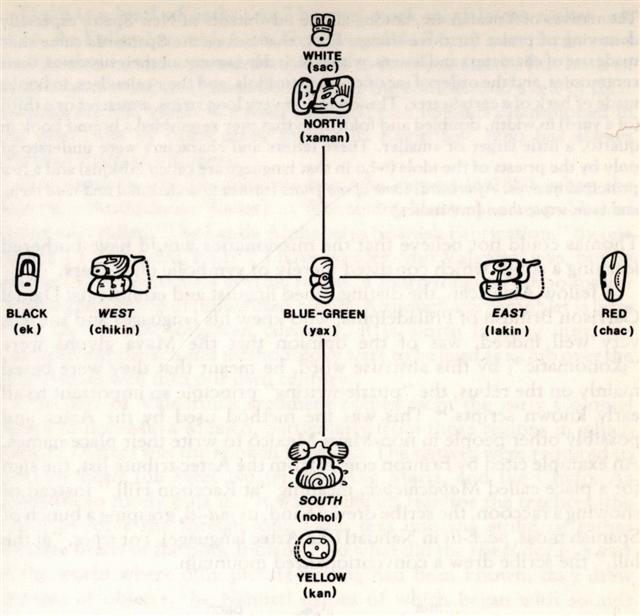
The death skull man (tagata)
in APRIL 1 might indicate that the year will be completed in the
north (cfr at left in Xaman above):

And
August 14 (226) - June 4 (155) = 71
→ 26000 / 365¼ = 71.184 ...
The Golden Fish (Dorado) was now
no longer swimming safely but was 'currently' moving
straight
down towards the south pole star (Dramasa).
... The word is from the Spanish, and
refers not to our little exotic cyprinoid, but to the large
coryphaena of the tropical seas, of changing colours at
death ...
... Far away, the Mangaians of old (Austral
Islands, Polynesia), who kept the
precessional clock running instead of switching over to
'signs', claim that only at the evening of the solstitial days
can spirits enter heaven, the inhabitants of the northern parts
of the island at one solstice, the dwellers in the south at the
other ... Considering the fact that the crossroads of ecliptic
and Galaxy are crisis-resistant, that is, not concerned with the
Precession, the reader may want to know why the Mangaians
thought they could go to heaven only on the two solstitial days.
Because, in order to 'change trains' comfortably, the
constellations that serve as 'gates' to the Milky Way must
'stand' upon the 'earth', meaning that
they must rise heliacally either at the equinoxes or at the
solstices ...
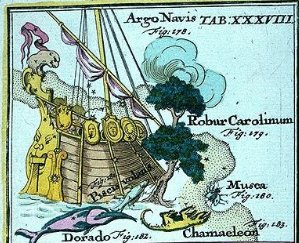
The ancient Mangaians had kept their eyes on the precession and
so would reasonably also the ancient peoples on Easter Island have
done, because they were on the same limb (branch):
Maga, Branch (of tree). Magahaiga, part of the arm
near the armpit, armpit. Magamaga: 1. Finger (rima
matu'a neanea, thumb; tuhi henua, index finger;
roaroa tahaga, middle finger; tuhia háûa, ring
finger; komaniri-komanara, little finger). 2. Seaweed
(shaped like small fingers). Vanaga. 1. (mama 2) A
mouthful; maga nuinui, to gobble. 2. Garbage. 3. Index
finger. 4. A branch; magamiro, a branch, a limb;
magamaga, fork, finger, claw, rod; magamaga miro,
a branch, a limb; magamaga rima, finger; magamaga vae,
toe; magamaga tumu, great toe; hakamaga, a roof;
magaga, fork; magatuhi, index finger;
hakamagaturu, slope of a roof. Churchill.
Reva. To
hang down; flag, banner. Revareva, 1. To be hanging
vertically; to detach oneself from the background of the
landscape, such a person standing on top of a hill:
ku-revareva-á te tagata i ruga i te maúga. 2. To cast
itself, to project itself (of shadows); revareva-á te kohu o
te miro i te maeha o te mahina, the shadow of the tree casts
itself in the light of the moon. 3. Uvula. Vanaga. To hang, to
suspend, flag, banner; hakareva, to hang up;
hakarereva, to hang up, to balance; hakarevareva, to
wave. T Pau.: reva, a flag; fakarevareva, to hang
up, to suspend. Mgv.: reva, a flag, a signal. Mq.: éva,
to hang up, to be suspended, to wave a signal. Ta.: reva,
a flag, banner; revareva, to wave. The germ sense is that
of being suspended ... any light object hung up in the island
air under the steady tradewind will flutter; therefore the
specification involved in the wave sense is no more than normal
observation. Churchill. Mgv.: 1. A plant. Ta.: reva, id.
Mq.: eva, id. Sa.: leva, id. Ma.: rewa-rewa,
id. 2. To cross, to pass across quickly; revaga,
departure. Ta.: reva, to go away, to depart. Ma.: reva,
to get under way. Churchill. Ta.: The firmanent, atmosphere.
Ha.: lewa, the upper regions of the air, atmosphere, the
visible heavens. Churchill.
.jpg)
|

















.jpg)